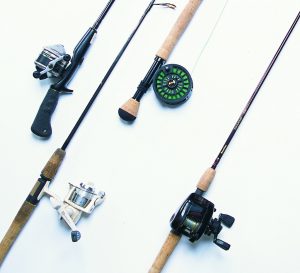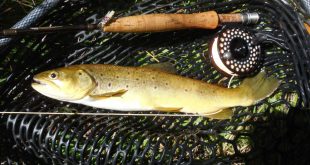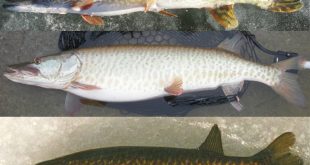
By Larry Pape
Nebraska Game and Parks Commission
How much time do you want to spend untangling your fishing line? Zero, none, never! While I cannot guarantee you a tangle-free life, there are ways to help spend more time fishing, and it starts by using the right gear for the conditions and your skill level.
If you are teaching a beginning angler, here is what they need to know about rods, reels and line.
Reels
There are four types of fishing reels. Each has its own advantages and disadvantages:
• Most spin-casting reels, also known as close-face reels, operate with the push and release of a button. The line seldom comes off the spool in a tangle. There are few exposed parts to break. The price and quality can be anywhere from disposable to heirloom. Perfect. Old anglers, once they have shed their egos, often come back to use the ones they learned to fish with. Buy one of these for your kids and save it for your grandchildren.
• Spinning reels look cool with the bail spinning the string on the spool as the handle is cranked. In the right hands, the spinning reel can cast farther than any other type as the line just falls off the end of the spool. These take a little more finesse, but can be used successfully by practiced beginners.
• A bait-casting reel often is a finely crafted machine in which the line comes off a spool that spins as you cast. The problem is, because the spool can keep spinning after you cast, a huge tangle called a bird’s nest can happen. These reels are efficient for long days of fishing, but are not best for beginners.
• A fly-fishing reel just holds string while not in use; it doesn’t help in casting. Unless you are angling with a special fly rod, you will not need this.
Rods
The fishing rod should match the reel type to ensure the rod functions correctly. By purchasing a rod and reel combo, in which both pieces of equipment already are fit together, you will guarantee to get a match. The combo comes in a light, medium or heavy action.
A light action rod will work best for lightweight bluegill, crappie and trout. Bass, carp and channel catfish can usually be handled with a medium or medium-heavy action setups. The only time to consider using a heavy action rod is if you are going after a giant flathead catfish or snagging a paddlefish.
Line
Fishing line also should match the reel size and type. Line is rated for how much weight it takes to break (test strength), and bigger is not better. Monofilament line that is 4- to 8-pound test is best for light-action gear, 10- to 20-pound test for medium action, and 20-pound test up to line that looks like weed-whacker string for heavy-action gear. Super-strength braided string requires special knots and considerations and is more expensive.
If you are just getting into fishing, a helpful resource for all things beginner is Game and Parks’ Going Fishing Guide, available at OutdoorNEbraska.gov/howtofish. If you want to take a new angler fishing and become eligible to win prizes, register for the Take ’em Fishing Challenge at OutdoorNebraska.org, where fishing permits also are available for purchase.
Photo: Types of fishing reels that can be paired with rods include, from top left to right, spin-casting and fly, and bottom left to right, spinning and bait-casting. (Nebraskaland Magazine/NGPC)
Read more fishing tips:
Whether releasing or keeping, handle fish with care
How to plan successful fishing trip
Simple setup all that’s needed to get started fishing
Well-tied knots important for any new angler
 Nebraskaland Magazine
Nebraskaland Magazine



